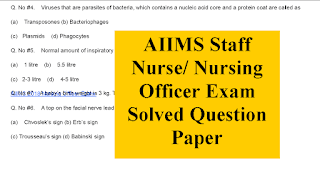AIIMS Nursing Officer Exam Solved Question paper and Model Questions are important to get better knowledge before going to write AIIMS Examinations for the the post of Nursing Officer, Staff Nurse, Nursing tutor. Every year All India Institute of Medical Science conduct Online/ offline Examinations for Recruiting vacant Nursing Posts. WWW.NURSINGWORK.IN is already published many Nursing Examinations Question Papers with Answers. You may also go through other Nurses Recruitment Examination like ESIC Examination Question Papers, KEA Staff Nurse Recruitment Examination Question Papers, Kerala PSC Examination Question Papers NHM Staff Nurse Exam Question Papers, Railway RRB Exam Question Papers.
Here we published 20 Model AIIMS Nursing Officer Exam Questions with Ready Answers (provided in the bottom of the post). More Question Papers of AIIMS Staff Nurse/ Nursing Officer Exam link in pdf format also provided below. Feel free to comment on the comment box below for any clarification and if you want any other Nursing Exam Question papers
Latest Staff Nurse Vacancies- Click here
Q. No #1. Which of the following is not a proximate principle?
(a) Protein (b) Carbohydrate
(c) Vitamin (d) Fat
Q. No #2. Recommended daily intake of vitamin A in adult is
(a) 200 mcg (b) 300 mcg
(c) 400 mcg (d) 600 mcg
Q. No #3. Identify the mineral which is responsible for myocardial contraction and relaxation
(a) Sodium (b) Calcium
(c) Potassium (d) Magnesium
Q. No #4. Viruses that are parasites of bacteria, which contains a nucleic acid core and a protein coat are called as
(a) Transposones (b) Bacteriophages
(c) Plasmids (d) Phagocytes
Q. No #5. Normal amount of inspiratory reserve volume in an adult is
(a) 1 litre (b) 5.5 litre
(c) 2-3 litre (d) 4-5 litre
AIIMS 2018 Nursing Officer Exam
Q. No #6. A top on the facial nerve leads to spasm of facial muscles. This is known as
(a) Chvoslek’s sign (b) Erb’s sign
(c) Trousseau’s sign (d) Babinski sign
Q. No #7 A baby’s birth weight is 3 kg. Then at 5 months the weight of the baby should be
(a) 5 kg (b) 6 kg
(c) 9 kg (d) 7 kg
Q. No #8.. Which of the following fontanelle in the child is the first to close?
(a) Frontal (b) Occipital
(c) Sphenoid (d) Mastoid
Q. No #9. Which of the following is the most effective treatment for children suffering from Thalassemia?
(a) Bone marrow transplantation
(b) Chemotherapy
(c) Steroid therapy
(d) Radiation therapy
Q. No #10. Management of child during temper tantrum include all except
(a) Deviate the attention from immediate cause
(b) Protect the child and others from injury
(c) Scold and beat the child
(d) Parents should be firm, calm and loving
Q. No #11. Which of the following is not a clinical manifestation of marasmus?
(a) Edema
(b) Body weight <60% of the expected
(c) Depletion of fat & adipose tissue
(d) Arm circumference is less
Q. No #12. Which of the following is the commonest surgical disorder of stomach during infancy?
(a) Pyloric stenosis
(b) GERD
(c) Hirschsprung’s disease
(d) Toxic megacolon
Q. No #13. Which of the following is not a characteristic of pathological jaundice in new borns?
(a) It appears within 24 hours of birth
(b) Total bilirubin level is more than 15 mg/dL
(c) Serum bilirubin level does not exceed 15 mg/dL
(d) Direct bilirubin level more than 2 mg/dL
Q. No #14. A research study describing the evolution of nursing education in India, is an example of
(a) Longitudinal study
(b) Experimental study
(c) Evaluative study
(d) Historical study
Q. No #15. Accuracy and consistency of a research tool is known as
(a) Validity (b) Reliability
(c) Objectivity (d) Sensitivity
Q. No #16 In which age group diphtheria is commonly found?
(a) 0-1 years (b) 1-3 years
(c) 1-5 years (d) 5-7 years
Q. No #17. Average length of a new born baby is
(a) 40 cm (b) 50 cm
(c) 35 cm (d) 60 cm
AIIMS 2015 Nursing Officer Exam
Q. No #18. A nurse is assessing a one month old baby and notes that the baby has low set ears. This may indicate
(a) Patau syndrome
(b) Klinefelter’s syndrom
(c) Edward’s syndrome
(d) Down syndrome
Q. No #19. In an infant, moro reflex disappears by
(a) 3 months (b) 6 months
(c) 10 months (d) 12 months
Q. No #20. A new born baby is placed under phototherapy for neonatal hyperbilirubinemia. The nurse explains the mechanism of action of photo therapy as
(a) Converts bilirubin into albumin
(b) Converts unconjugated bilirubin into soluble bilirubin
(c) It inhibits bilirubin formation
(d) Converts conjugated bilirubin to unconjugated bilirubin
ANSWERS
Answer for Q. No 1 Option C
Answer for Q. No 2 Option D
Answer for Q. No 3 Option C
Answer for Q. No 4 Option B
Answer for Q. No 5 Option C
Answer for Q. No 6 Option A
Answer for Q. No 7 Option B
Answer for Q. No 8 Option B
Answer for Q. No 9 Option A
Answer for Q. No 10 Option C
Answer for Q. No 11 Option A
Answer for Q. No 12 Option A
Answer for Q. No 13 Option C
Answer for Q. No 14 Option D
Answer for Q. No 15 Option D
Answer for Q. No 16 Option C
Answer for Q. No 17 Option B
Answer for Q. No 18 Option D
Answer for Q. No 19 Option B

Comments
Post a Comment